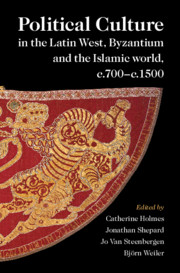 Political Culture in the Latin West, Byzantium and the Islamic World, c.700–c.1500
Political Culture in the Latin West, Byzantium and the Islamic World, c.700–c.1500 Book contents
- Political Culture in the Latin West, Byzantium and the Islamic World, c.700–c.1500
- Political Culture in the Latin West, Byzantium and the Islamic World, c.700–c.1500
- Copyright page
- Contents
- Figures and Maps
- Contributors
- Preface and Acknowledgements
- Abbreviations
- General Maps
- 1 Political Culture in Three Spheres
- 2 Reflections on Political Culture in Three Spheres
- Part I Sources
- Part II Historical Contexts
- 7 The Latin West
- 8 Byzantium
- 9 The Islamic World
- Part III Norms, Values and Their Propagation
- Part IV Practice and Organisation
- Part V Conclusions
- Appendix
- Glossary
- Index
9 - The Islamic World
Conquest, Migration and Accommodating Diversity
from Part II - Historical Contexts
Published online by Cambridge University Press: 11 August 2021
- Political Culture in the Latin West, Byzantium and the Islamic World, c.700–c.1500
- Political Culture in the Latin West, Byzantium and the Islamic World, c.700–c.1500
- Copyright page
- Contents
- Figures and Maps
- Contributors
- Preface and Acknowledgements
- Abbreviations
- General Maps
- 1 Political Culture in Three Spheres
- 2 Reflections on Political Culture in Three Spheres
- Part I Sources
- Part II Historical Contexts
- 7 The Latin West
- 8 Byzantium
- 9 The Islamic World
- Part III Norms, Values and Their Propagation
- Part IV Practice and Organisation
- Part V Conclusions
- Appendix
- Glossary
- Index
Summary
This chapter provides a brief overview of the political history of the Islamic world, from the seventh-century Arabian conquests to the formation, during the fifteenth and sixteenth centuries, of the three great early modern Muslim empires: the Ottomans in Asia Minor, the Safavids in Iran and the Mughals in India. Its structure reflects the major political formations and transformations of this period: firstly, the Arabian ‘conquest polity’ which replaced the antique balance between Rome and Iran; then, after the demise of that empire in the mid-tenth century, the tumultuous era of ‘Berber’, Daylami and Turkic leaderships; finally, following the cataclysmic Mongol conquest of the eastern Islamic lands in 1258, the assimilation of these conquerors in the east and the political achievements of Turco-Mongol military strongmen and entrepreneurs in Syria, Egypt, Yemen and Anatolia. It looks at the elites and political structures that shaped and underlay this history and at their interaction with Islam. This had developed into a more fully articulated and stable ideological system, whose continued success lay in the new elites’ capacity to adopt and adapt it to their needs.
Keywords
- Type
- Chapter
- Information
- Political Culture in the Latin West, Byzantium and the Islamic World, c.700–c.1500A Framework for Comparing Three Spheres, pp. 212 - 248Publisher: Cambridge University PressPrint publication year: 2021


